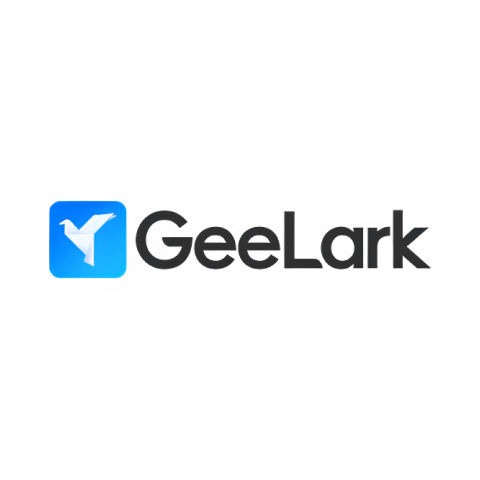
GeeLark
GeeLark is an anti-detect cloud phone platform where you can use multiple instances of Android-powered virtual smartphones from any browser. Each of these cloud phones has unique device information, making the platform a perfect fit for mobile app multi-accounting.
For this review, I’ve subscribed to GeeLark’s paid plan to test features like multi-account management and synchronizer. I’ll evaluate its use cases, benefits, and drawbacks to help you determine if GeeLark is worth investing in for your business needs.
Features
-
Simulate Android and iOS (coming soon) devices
-
Use several anti-detect cloud phones from a single PC
-
Google Play Store and native app marketplace
-
Task automation templates and customization
-
Flexible pay-as-you-go and monthly subscriptions
Pros
-
Anti-detect cloud phones with randomized user information
-
Independent of local device capabilities
-
Endless possibilities with multiple task automation workflows
-
Free trial even with personal email accounts
Cons
-
Certain apps, such as camera, suffer from a slight lag
-
Can’t choose cloud phone server location
GeeLark Review Methodology
Geekflare tested GeeLark, a cloud-based antidetect phone solution for managing multiple mobile accounts without physical devices. We evaluated multi-account management, proxy integration, and synchronizer. Combining hands-on testing and user feedback, we provide an unbiased review of GeeLark’s efficiency and versatility.
Social media companies such as Meta routinely take down “fake accounts”. It chopped off 1.1 billion suspicious profiles in the third quarter of 2024. In addition to malicious behavior, Facebook makes it difficult for businesses to have more than one account within a single browser.
While this problem is well taken care of by multi-accounting browsers, there is was no solution if you want to maintain multiple profiles with a platform’s native application. Obviously, it’s not feasible to own a “physical” device for every app account.
This is problematic for businesses since they have many things on their plates (such as user experience validation, marketing campaigns, giveaways, ads verification, etc.) for which they need actual “unique” devices.
The objective is simple—bypass account bans and appear as real users in locations of business interest.
GeeLark aces this use case. You can create multiple profiles (each acting as a separate cloud smartphone) without being restrained by the spec sheet of local devices. A web browser and a stable internet connection are all that you need to run mobile apps on a PC.
GeeLark Product Offering
It’s important to understand what GeeLark has in store for you. Fortunately, there are only two major segments: Virtual Cloud Phones and Browser Profiles. And the good thing is both of these are wrapped inside one simple interface.
- Virtual Cloud Phones: This will provide close to a real smartphone experience but in the cloud. You can sign up with Google, install apps, automate repetitive tasks, and more from your web browser. Virtual Cloud Phones is GeeLark’s flagship product. It allows setting up multiple anti-detect smartphones from a local device, such as a personal computer.
- Browser Profile: This one is for you if you’re not interested in simulating an entire smartphone but only a browser environment. Browser Profile is similar to antidetect browser solutions. You will have randomized parameters (timezone, webRTC, location, language, resolution, etc.) to avoid account bans. However, GeeLark also supports setting custom values for simulating specific device browsers.
I will keep Browser Profile limited to this section since this GeeLark review is chiefly about its antidetect phone functionality.
How Does GeeLark Work?
This section will show how to get started with GeeLark virtual phones.
Note: Before starting, ensure you’re subscribed to a proxy provider, such as Decodo or
IPRoyal , and have the connection details (username, password, and server address).
1. Setting up GeeLark profile(s)
Each GeeLark profile is a virtual smartphone in your hands. After opening the GeeLark app (available for Windows, macOS, and Linux), click New profile.

This leads you to a window for entering profile details, such as name, group, area, language, and proxy.
Name, group, etc., are optional and just for categorization. This will help if you’re using multiple profiles. The rest, most importantly proxy, are some of the parameters that make these virtual phones distinct.
You can either set the Area to Auto-match (the proxy IP address) or set Custom to choose a location (and time zone) of your choice.
Finally, you have to configure and change proxy settings to make these cloud-based Android OS instances operational. Since I already have a Decodo subscription, I’ve just added the proxy details.

Currently, GeeLark lets you deploy Android 10 to 13. All the versions support sound and camera, upload apps, and grant Play Store access (iOS simulation is coming soon).
GeeLark profile setup completes by specifying your desired Charging method (monthly or pay per minute), which I have discussed in detail in the pricing section.
2. Using Cloud Phones
GeeLark’s home page features a Start button for turning on cloud phones.
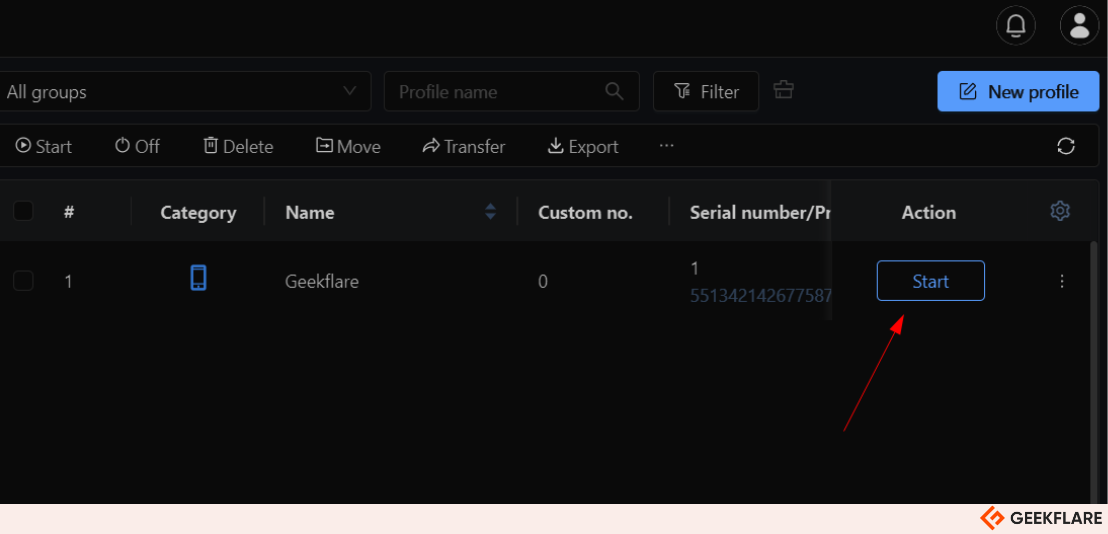
Once clicked, you will have to wait a few minutes before it opens a dedicated window for the cloud phone. Afterwards, you can pretty much use it like a normal phone from any browser.
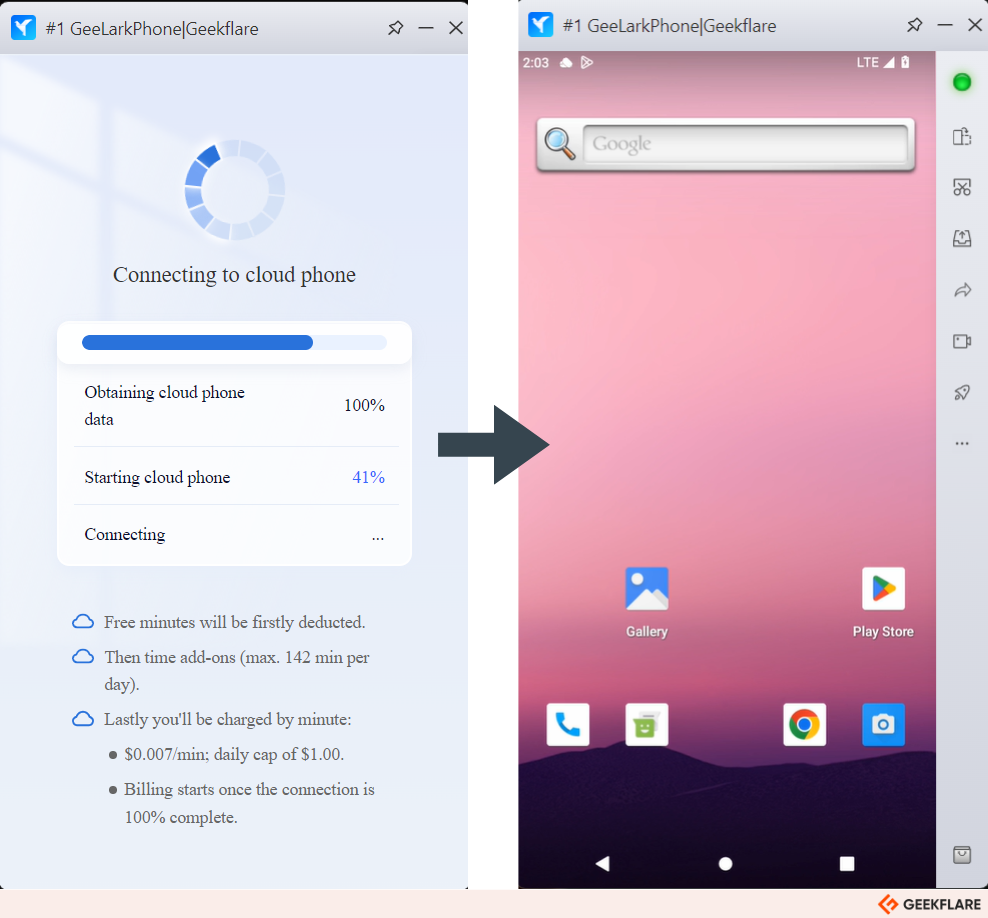
You can upload files, use a PC camera and microphone, take screenshots, change orientation, and more from the side tray.
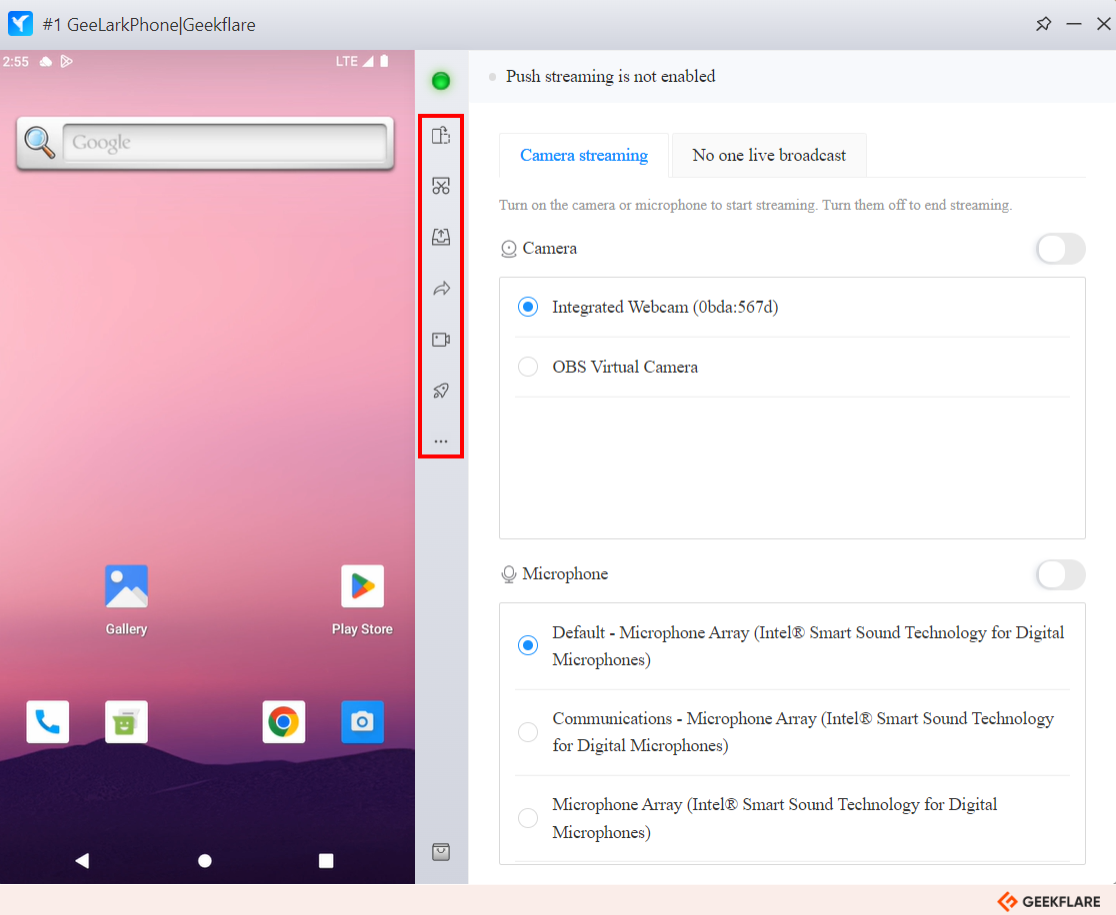
I configured it to use my laptop’s integrated webcam and tried using the preinstalled camera app. It worked similarly to a smartphone’s front camera experience.
Next, I opened the Google Chrome web browser and accessed Geekflare’s home page.
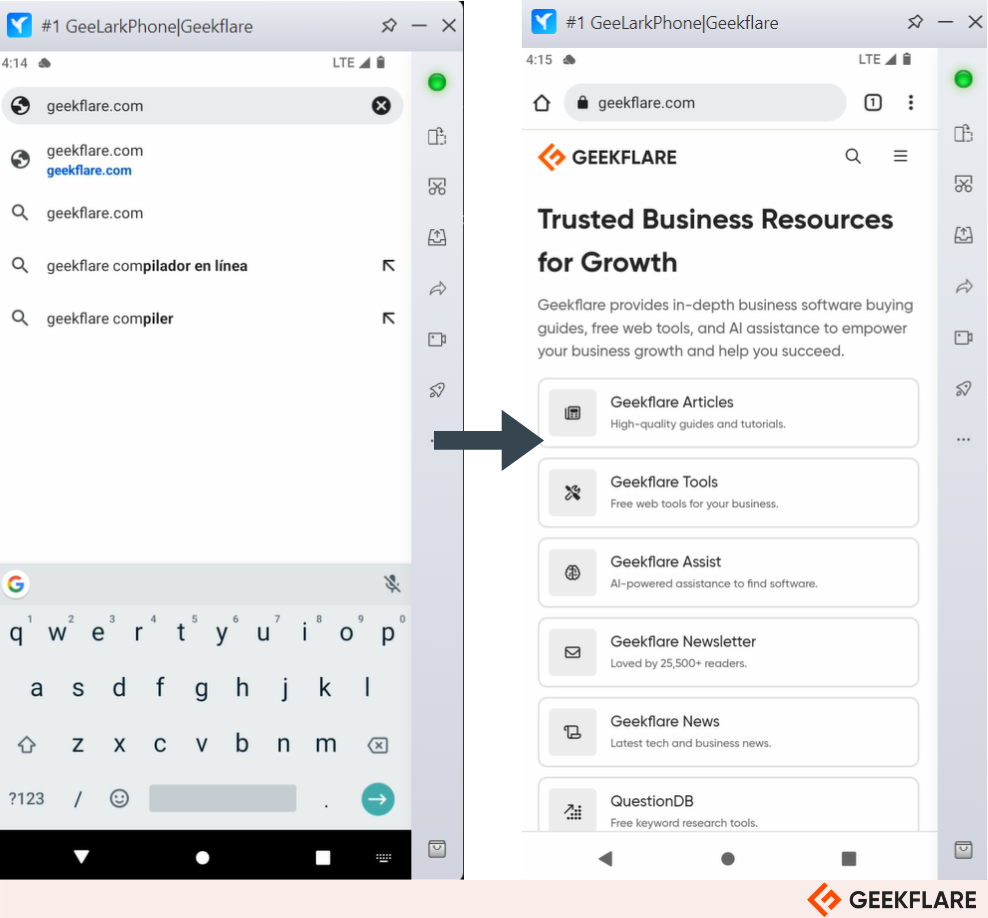
The overall feel is closely matched to physically holding a smartphone. I could scroll with my PC mouse and use the keyboard to type.
However, I did encounter some lag. While I could seamlessly stream YouTube in 4K, somehow, this wasn’t enough with GeeLark cloud phones. The culprit can be my distance from GeeLark’s cloud server, increasing latency.
3. Installing Apps
GeeLark’s major upside over an anti-detect browser is that you can install apps on it. You have two ways to do this.
You can log in to a Google Account and go with the Play Store. Alternatively, GeeLark has an integrated marketplace (marked as 1) to install apps without needing a Google Account.
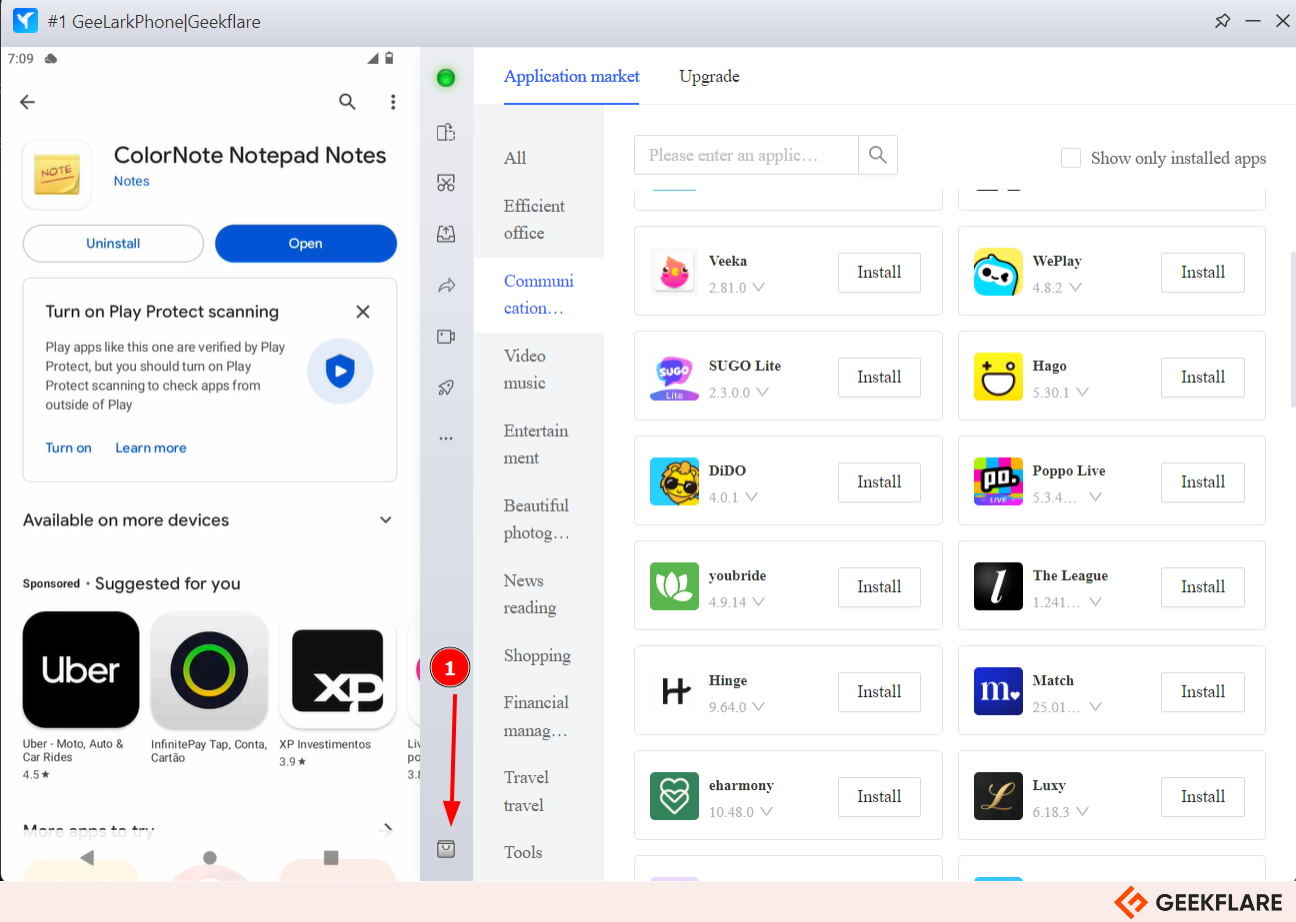
Both methods are efficient. However, I suggest using the latter, GeeLark marketplace, with a non-Gmail account to avoid detection. Even better, try to sign in with anonymous email providers such as
4. Task Automation
Task automation is the “thing” businesses will actually want GeeLark for. With multi-accounting at its heart, you can automate social media activity (like, shares, scheduled posting, following, commenting, etc.), account registration, batch profile editing, and much more.

GeeLark has pre-defined yet customizable workflows for TikTok, YouTube, and Facebook. Additionally, you have custom tasks to execute practically anything on its own.
5. Synchronizer
Synchronizer allows you to sync actions through the selected cloud profiles. This means every click, scroll, keyboard entry, etc., from the main window will be “streamed” across others.
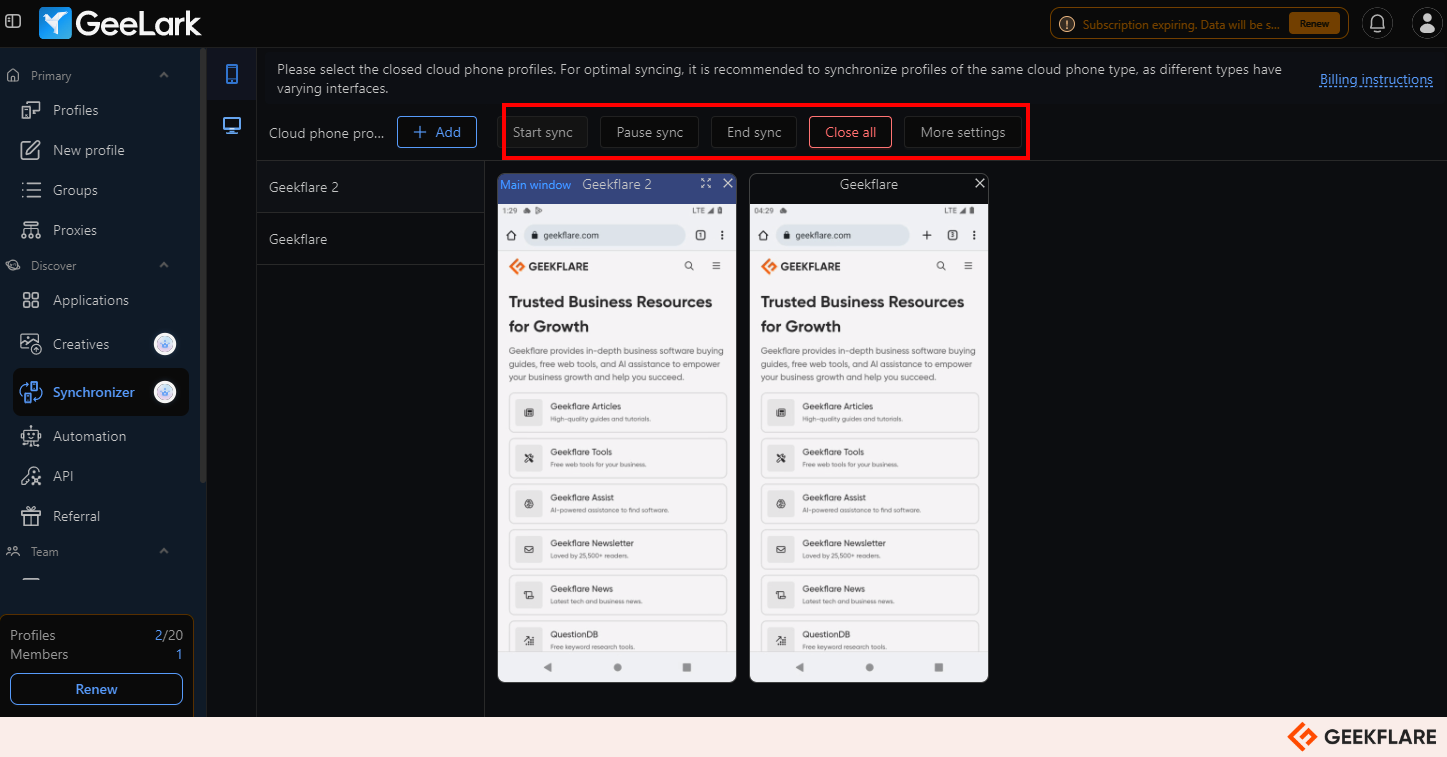
You can assign the “Main window” to the cloud profile of your choice. Besides, it’s easy to start, pause, and end sync to perform profile-specific actions.
Additional settings include setting frame rates for secondary profiles and turning on the sidebar.
Note: Synchronizer is a paid feature.
GeeLark Use Cases
There are some interesting ways to put GeeLark’s capabilities to work. I’ve discussed 3 main use cases below.
- Multi-accounting: GeeLark lets you manage multiple accounts with its GeeLark profiles. Every such profile acts as a standalone “cloud” smartphone with randomized parameters to bypass restrictions. These cloud smartphone instances have locally available apps and Google Play Store access.
- E-commerce products and Ads verification: Product and ad verification is vital for global businesses serving multiple locations. You need to know that the products/ads look as intended and troubleshoot any location-specific issues. It has become a business-critical aspect since ad spend is huge—was around 733 billion USD in 2023.
- Accessing geo-restricted content: Though it’s not the ideal use case (since there are cheaper and easier alternatives, such as a VPN), you technically can deploy GeeLark to gain access to geo-locked content. This can be location-based e-commerce deals, streaming content, or anything else.
Before you start using the platform, it’s necessary to understand that GeeLark is not an Android emulator. With GeeLark, all you install is its application, which provides the means to use the Android OS installed on its cloud servers.
Unlike with OS emulation, you’re not restricted by the local device computing. A stable internet connection is the only requirement for a lag-free simulation.
GeeLark Integrations
GeeLark readily integrates with Decodo, Proxyma, IP HTML, and Luminati (Bright Data). You can simply copy-paste the IP, and GeeLark fetches all other details. There are detailed guides on using proxies with the GeeLark app.
However, you can configure it with any HTTPS, HTTP, and SOCKS5 proxy. The only additional steps would be to enter authentication details.
GeeLark Pricing
GeeLark provides a complimentary one-time 30 mins to beginners. Afterward, you can continue with subscriptions.
In the table below, I’ve given the details for the various subscriptions that GeeLark offers.
| Plan | Free Mins | Features | Monthly Pricing |
|---|---|---|---|
| Free | 30 (One-time) | 2 Profiles, 1 additional seat | $0 |
| Base | 60-1,500 | 5-1,000 profiles, unlimited additional seats, task automation, ADB | $5-$139 |
| Pro | 60-15,000 | 20-10,000 profiles, unlimited additional seats, task automation, ADB, bulk profile, TikTok automation, synchronizer, AI editing | $19-$1,199 |
| Custom | Custom | Creation of more than 10,000 profiles, customized features | Custom |
Apart from the subscription-based cloud phone charges, time add-ons can be purchased, starting at $0.007/minute/phone (Android 11), with a daily expenditure cap of $1/phone.
Use code GEEKFLARE during checkout to get 15% off on your order!
Monthly Rentals
Renting a phone is for using a single cloud phone (~one GeeLark profile) without caring for the minutes. There are plans for 30 to 360 days starting at $24.9.
Who Should Use GeeLark?
GeeLark is a good match for several domains. But it primarily fits with marketers, developers, and agencies.
- Marketers: If you manage multiple social media accounts with native apps, GeeLark can be your savior! This allows you to use multiple “phones” from a single PC, synchronize repeated workflows, and deploy automation.
- Developers: You can easily test app behavior from various locations with GeeLark. It supports the Google Play Store and has a decently-sized native app store for installing apps without using a Google account.
- Agencies: Running multiple ads with a single ad account can often lead to bans. While this can be done more efficiently with an anti-detect browser, you can bank on GeeLark since it also features browser profiles.
Who Should NOT Use GeeLark?
Equally important is to know when you’re better off with something else and not an anti-detect cloud phone. Here are some cases when you shouldn’t use GeeLark, as there are better alternatives.
- You just need an anti-detect browser. GeeLark is not the right pick for someone needing anti-detect browser environments on their PCs. It won’t cut it for the comforts of a PC browser experience. Plus, it’s expensive, and latency can be a deal breaker if you have a slow internet connection. Instead, you can use a multi-accounting capable web browser.
- You want to stream geo-locked content. You should absolutely avoid GeeLark if the chief objective is streaming restricted content. A good virtual private network (VPN), such as
Proton VPN orSurfshark , will do this job for a fraction of the cost and without all the hassle. - You need a fast, snappy smartphone. GeeLark is hosted in cloud servers, which can be at a significant distance from your physical location. This will inadvertently induce latency, ruining the point of a cloud phone. Besides, a cloud phone can never replicate an actual smartphone because of issues such as shared infrastructure. That’s why you should take its 30 mins trial to experience it yourself.
GeeLark Verdict: Is it Worth Using?
GeeLark is a one-of-a-kind product that has enormous value for the right business use cases. I recommend GeeLark to anyone looking to automate mobile app workflows with multiple accounts. It has task automation templates for TikTok, Facebook, and YouTube, and you can also create custom ones.
Its user interface is intuitive enough, and setup isn’t difficult either. Additionally, you have its documentation to help you out.
There is only one potential deal breaker—latency, which is subjective to locations. That’s why, I repeat, take the free trial before paying, and there will be no regrets.
Based on my evaluations, GeeLark receives the Geekflare Innovation Award for its unique virtual phone offering. Whether you want to perform ad verification, manage accounts on social media platforms, or test app behavior, GeeLark presents flexible workflows for various use cases.

